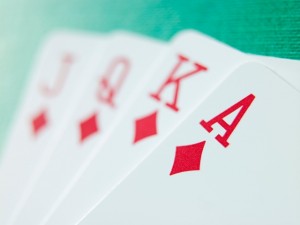 These days there is a vibrant and varied retail market showcasing all different kinds of Tarot and Oracle cards available in New Age shops and bookstores other high street, with even more diverse divination decks to browse online. But divination through playing cards is a little-known British tradition, readings originally given by people in the local neighbourhood with these ordinary cards produced extra-ordinary insights.
These days there is a vibrant and varied retail market showcasing all different kinds of Tarot and Oracle cards available in New Age shops and bookstores other high street, with even more diverse divination decks to browse online. But divination through playing cards is a little-known British tradition, readings originally given by people in the local neighbourhood with these ordinary cards produced extra-ordinary insights.
Traditional English Divination
It is thought that the symbols of our modern playing cards originate from fifteenth century France, with the symbols of Tarot modified to use the cards for gaming purposes. In England, Tarot cards were hard to get a hold of so ordinary playing cards were used for divination instead.
Robert Chambers explains the English system in the article ‘The Folk-Lore of Playing Cards’ published in 1869 by W. & R. chambers, London and Edinburgh. Chambers was born in 1802 (around the time of the Napoleonic wars and of Lenormand!) and learnt the art of divination from a soldier’s wife who cared for him as a child. This form of cartomancy was practiced by soldiers’ wives, who practiced and taught this British System of card reading in their local communities who were “peculiarly skilled practitioners of this art”.
Chambers describes how card readers had a positive impact within the poor communities, offering good advise, morale support and sympathy in time of war, and how a good cartomancy practitioner did not make over-dramatic claims or predict doom-and-gloom prophecies, but instead they pointed out “the cards of caution” and gave their clients advice on how to avoid the pitfall that the card represented. If we consider that the soldiers’s wives would have learnt it from their mother or elder (and so on), then this tradition could have originated from the eighteenth century. Some of the meanings of the danger cards in the traditional British system, such as “duel” or “death on the scaffold” (hanged), are a testament to the age of this method, and would need to be adjusted in order to have relevance to today’s modern world.
Curious Card Correspondences
Doreen Valiente wrote of the magical links and connections between playing cards in 1975. Valiente explains how the numerical system of the cards corresponds with the annual year. There are 52 cards in a standard deck of ordinary playing cards- one card for each week of the year. The four suits could be the four seasons (winter, spring, summer, autumn) as each suit has thirteen cards, as does each quarter of the year, having thirteen weeks in a season. The twelve court cards are like each month within a year and the twelve hours between noon and midnight.
The numbers (or ‘pips’) of each suit from ace to ten total to 55. If Jack is 11, Queen is 12 and King is 13 then the total of each suit is 91. When this is multiplied by 4 it gives the final total for the whole pack: 364- and when we add the Joker of 1, we have 365, the number of days in a year.
The colours of red and black can mean day or night. The four suits could also represent the four winds (north, south, east, west) or the four elements (earth, air, fire, water).
The four suits of thirteen cards can also be seen to follow the lunar cycle of new moon, first quarter, full moon, last quarter the four phases of the moon make a lunar month; approximately thirteen lunar months are in one year.
Quick Yes/No Draw
You may like to try a fun draw to get a yes/no response to a question you may have. Shuffle the deck thinking of your yes-no question, cut the deck in half and choose a card from the top of one of the halves….if the card suit is Hearts or Diamonds (symbols of treasure) it means Yes, but if the card suit is Spades or Clubs (symbols of weapons) it means No.
Written by Tahlia #0450


